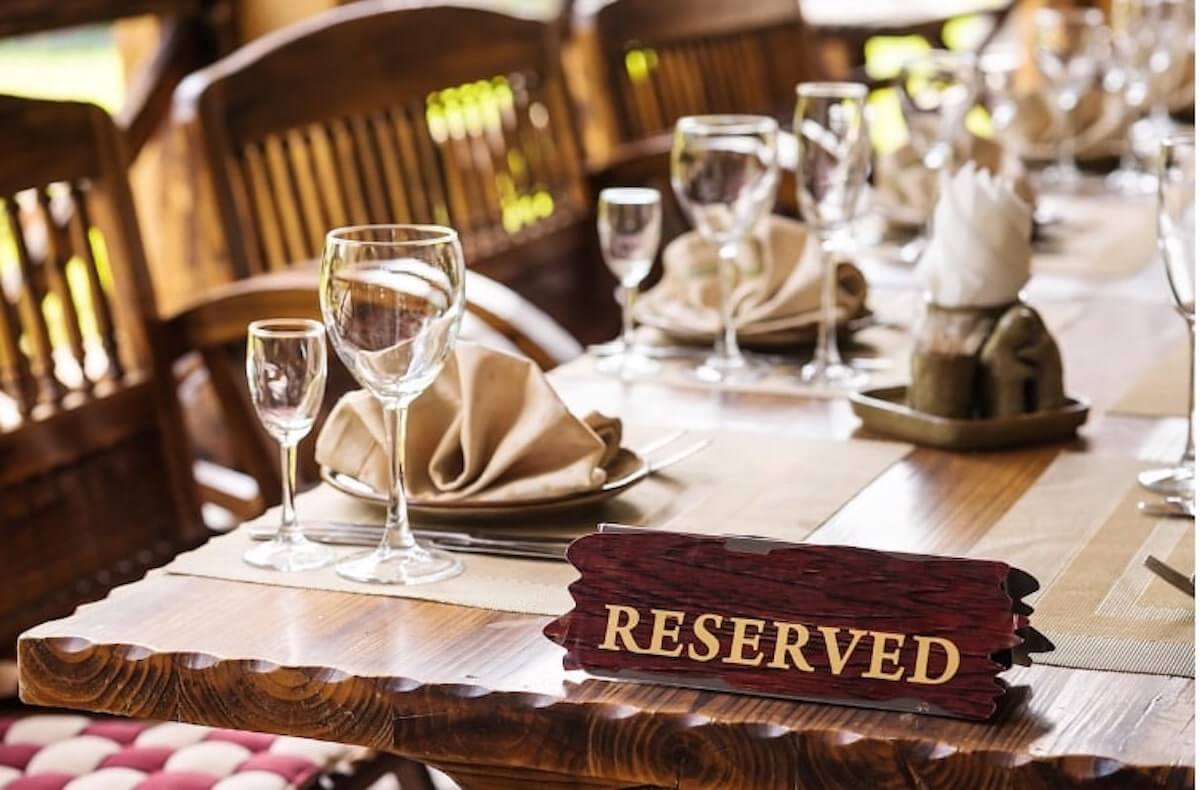How to choose your restaurant front-of-house system
Skip the article and turn takeaways into action by scheduling a call with our team.
Restaurant front-of-house systems are, in many cases, the backbone of the dining experience. Without the proper technology, effectively managing restaurant reservations and communicating accurate wait times can be a nightmare for even the most experienced general managers and staff members. Then comes the added hurdle of using that FOH system to connect the front of house with the back of house, or BOH, for a seamless dining experience.
Effective FOH systems will allow restaurant owners to give hosts, servers, and managers a huge leg up in terms of effective guest communication, while also maximizing seating and sales. Wondering how to choose a front-of-house system that’s perfect for your needs? We’ll guide you through what you need to know.

Front-of-house basics
Let’s get some basics out of the way first—just what is the front of the house?
In a restaurant, front of house is where the customer experience all happens. It includes the dining area, outdoor seating, waiting area, bar (if applicable), restrooms, and often the house manager’s station. This is where the restaurant earns its income, and where customers interact with the restaurant.
Customers gather a lot of information about a restaurant from the FOH. Essentially everything your customers experience in your restaurant happens in the front of the house. Your customers aren’t walking to the back to interview the dishwashers or nag the kitchen staff. They’re interacting directly with your front-of-house team: placing drink orders, considering prices, perusing the wine list…and eating, of course.
A well-run FOH is a moving work of art. Delegating tasks usually falls to the front-of-house manager, who may wear many hats depending on the size of your restaurant. Servers may double as food runners or simply handle orders, leaving the table service to food transportation specialists. A host/hostess may be in charge of seating, or you could opt for kiosk seating. There are a lot of options and as many different front-of-house arrangements as imaginable.
The FOH is one of the two wagon wheels in the restaurant business, with the BOH representing the other. Both wheels need to turn together in order for the wagon to move in the right direction. Having a front-of-house system that works well is crucial to the teamwork of both wheels.
Why invest in a front-of-house system?
Front-of-house systems are extremely important tools for effective restaurant management. In fact, 54% of diners say that online reservations are a restaurant’s most important technology feature. Managing reservations and wait times is no easy task, and those who take a DIY approach that relies on phone calls and physical reservation books will often find themselves losing out on both time and money.
Think about the following when considering the value of a restaurant FOH system:
- Search engine optimization perks: If a customer wants to find a place for dinner, they’re overwhelmingly likely to search the web, and the ability to book a table online will boost conversion dramatically.
- 24/7 reservations: You won’t have to lose reservations to competitors with an online booking system. Customers will be able to make reservations even when you’re closed or too busy to pick up the phone.
- Virtual waitlists: Given the choice between a restaurant where customers can immediately put their names on a waitlist and a restaurant where they have to hope their call can get through during the dinner rush, they’ll likely go with that first option.
- Saved customer preferences: When customers are greeted by wait staff who know their favorite orders, regardless of whether they’ve ever tended to them before, chances are they’ll keep coming back.
Front-of-house systems prove far superior in each of these scenarios and many more. While they do require some investments of time and money from restaurant owners and restaurant management, the long-term benefits from both labor savings and new business far outweigh the costs, and serve as a powerful tool to handle peak service periods.
What types of restaurants need FOH systems?

Front-of-house systems benefit a wide range of restaurants. If your restaurant falls into one or more of these categories, you’ll certainly want to consider an FOH system:
- Full-service restaurants that either take reservations or would like to start taking reservations
- Restaurants that would like to take bookings online
- Restaurants that have at least one period a week where walk-in guests may have to wait for a table
- Established restaurants with so much natural demand that they need a FOH tool to help staff manage their customer flow
There are also some restaurants that don’t necessarily need an FOH system:
- Quick-service restaurants and related businesses that don’t rely on dine-in traffic
- Restaurants that don’t take reservations and/or don’t see large enough crowds to have regular wait times
These cases are few and far between, and for most establishments, an FOH system is like a receptionist that can take bookings for you any hour, any day.
Front-of-house systems should value guest experience above all else
While some restaurants may have great curb appeal, beautiful landscaping, or entryways that easily draw in traffic, nothing will turn off prospective customers like a packed waiting area with people nagging staff members about when their table will be ready.
Setting clear expectations around restaurant reservations and wait times is of utmost importance, so those sacred first impressions remain positive, even for walk-ins arriving at peak hours.
An effective front-of-house system should allow guests to make a reservation online, if your restaurant takes reservations. In either case, potential walk-ins should also know how long wait times are before leaving home, and even better, be able to add themselves to the waitlist before arriving.
When you’re managing a busy FOH, customers can definitely pick up on the vibe. If they feel like the staff is handling things professionally and competently, they’ll feel comfortable—and likely to both stay and return.
Communication is critical on site, and a good FOH system will keep wait times updated, saving your front-of-house staff the stress and countless hours of addressing customer questions and complaints.
In smaller restaurants, where wait staff and bussers may double as hosts, minimizing time spent in the waiting area will boost dining room morale and front-of-house operations significantly.
FOH and BOH systems should talk to each other

Your wait staff can only turn tables as quickly as your back-of-house staff can handle orders. Successful restaurants not only design their kitchens to be as efficient as possible, but also ensure that their technology platforms can integrate with one another, creating a seamless experience for guests and staff members alike.
With table management and POS systems being two of the most important tools for the front and back of the house, connecting the two plays a critical role in optimizing whole house operations.
When front-of-house employees put orders into your POS system, the head chef and back of the house employees then make sure those orders come out as requested. Modifications and customizations can get lost in the shuffle, however, and that will throw off even the most experienced staff members.
As guests return time and time again, however, the right front-of-house system can collect data on those patrons, remembering their orders and preferences.
Integrating your Guest Management and POS systems allow wait staff to spend more time tending to guests and less time preoccupied with entering orders, allowing them to turn tables faster and ultimately boost sales with greater occupancy.
Front-of-house systems should be easy
Front-of-house employees, from wait staff and bussers to sommeliers and even general managers, can have notoriously high turnover rates. New hires require training, and minimizing the time and energy needed to onboard staff members will greatly improve restaurant management and sales.
Technology onboarding is a huge part of new hire training, so a simple FOH system will play a critical role in getting front-of-house staff members up to speed. Understanding how to process reservations, assign tables, manage waitlists, and communicate with incoming guests can quickly become complicated and overwhelming to learn. And under the stress of peak hours filled with hungry guests, there’s potential for disastrous consequences.
A Guest Management system that’s easy to learn and manage will help front-of-house staff efficiently and effectively manage guests to create a positive first impression, which will in turn ease the burden on wait staff in the dining room.
Yelp Guest Manager: The recommended front-of-house system
Restaurant owners have a variety of choices when trying to figure out how to choose a front-of-house system. From OpenTable to Resy and beyond, each option has its own distinct interface, features, benefits, and costs.
If you’re looking for an all-encompassing FOH system that’s easy to use, integrates with your POS system, and ensures a smooth guest experience, Yelp is a fantastic option. With 92 million people searching each month, your potential customers are likely already checking Yelp for the best spot to eat out.
Yelp allows restaurant owners and operators to easily attract and interact with diners, tapping into Yelp’s broad network to convert hungry prospects to satisfied patrons.
Customers can book a reservation with you or add themselves to your waitlist with one touch. With live status updates, Yelp helps reduce the chance of no-shows and line abandonments while relieving front-of-house staff from fielding questions about the wait time.
Plus, Yelp integrates with an array of POS systems, such as NCR Aloha, Dinerware, and Oracle Micros, to track customers’ order histories, preferences, and major events like birthdays and anniversaries.
Start boosting business today with Yelp for Restaurants.